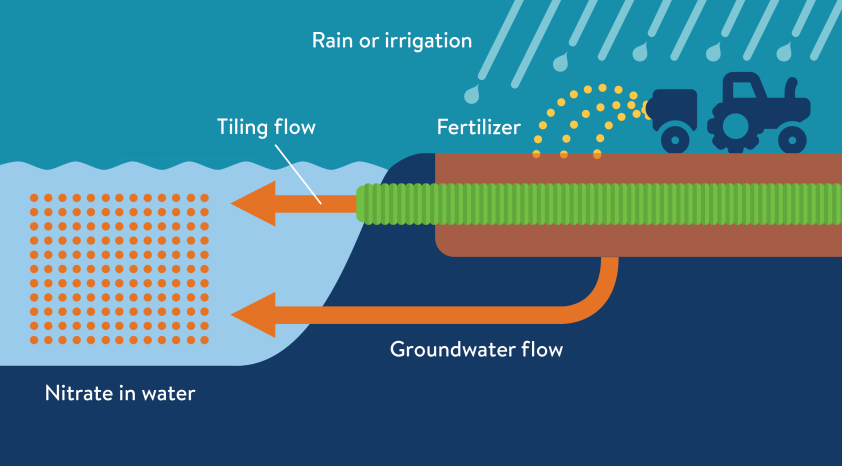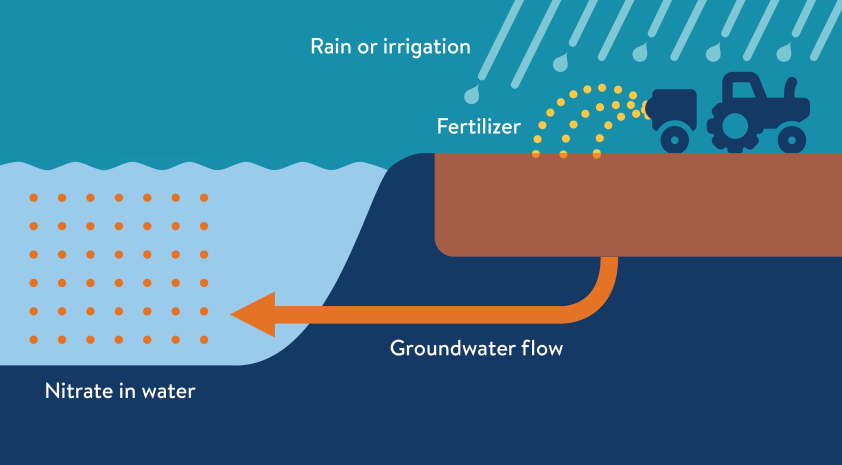Nitrogen, like phosphorus, is a nutrient that pollutes in state waters, and its concentration in many rivers has been increasing from historic natural levels over time due to human influences.
Statewide, data on nitrate concentrations in rivers over the past 20 years show a mixed bag:
- many monitoring sites with variable levels and no trend
- many sites where levels have increased
- some sites where levels have decreased
Sources
More than 70% of the nitrate in Minnesota waters is coming from cropland, the rest from regulated sources such as wastewater treatment plants, septic and urban runoff, forests, and the atmosphere. Nitrate leaching into groundwater below cropped fields and moving underground until it reaches streams contributes an estimated 30% of nitrate to surface waters. Groundwater nitrate can take from hours to decades to reach surface waters.
Cropland sources account for an estimated 89% to 95% of the nitrate load in the Minnesota, Missouri, and Cedar Rivers, and Lower Mississippi River basins.
Tile drainage pathway
In tiled cropland, most of the rainwater that ends up in surface water (ditches, streams) flows through tile drainage. This water can be high in nitrate, but it is also potentially easier to control.
Groundwater pathway
In cropland without tile drainage, most rainwater flows through the ground to get to surface waters. As it travels through the earth, some of the nitrate is removed, resulting in less nitrate reaching our streams and rivers. However, there are fewer options of controlling this kind of nitrate pollution once it moves below the crop roots.
Crop drainage with tiling

Crop drainage without tiling

Human health and environmental concerns
Nitrate (a form of nitrogen) in lakes, rivers, and streams is toxic to fish and other aquatic life; in drinking water, it's potentially harmful to humans. Proposed reductions in nitrogen will benefit both Minnesota waters and water downstream from us.
Ammonia is a form of nitrogen that is directly toxic to aquatic life. It comes from wastewater treatment plants and animal waste or air pollution and runoff from agricultural land. Water with high concentrations of ammonia allow the chemical to build up in the tissues and blood of fish, and can kill them.
Nitrate in the Mississippi River
On average, 158 million pounds of nitrate leave Minnesota per year in the Mississippi River — 75% comes from Minnesota watersheds.
Nitrate leaving Minnesota via the Mississippi River contributes to the oxygen-depleted dead zone in the Gulf. This dead zone cannot support aquatic life, affecting commercial and recreational fishing and the overall health of the Gulf. Nitrate concentrations have steadily increased in the Mississippi River since the mid-1970s.
Monitoring, reporting, and regulations
The MPCA’s research shows elevated nitrate levels in water, particularly in the southern third of Minnesota.
Reducing nitrate
Tactics for reducing cropland nitrate that reaches surface waters fall into three categories:
- Manage in-field nutrients – Optimize fertilizer rates, apply fertilizer closer to timing of crop use
- Manage and treat tile drainage water – Plan tile spacing and depth, control drainage, construct and restore wetlands for treatment purposes, use bioreactors
- Diversify vegetation/landscape – Plant cover crops, plant more perennials on marginal cropland
Nitrate fertilizer efficiency is improving and further refinements in fertilizer rates and application timing could reduce nitrate loads by roughly 13% statewide. But additional and more costly practices will also be needed to make further reductions and meet downstream needs. Statewide reductions of more than 30% are not realistic with current practices.
Bigger reductions would require limiting nitrate leaching across large parts of southern Minnesota, particularly on tile-drained fields and row crops over thin or sandy soils. Only collective incremental changes by many over broad acreages will result in significant nitrogen reductions to downstream waters.
The Department of Agriculture's Nitrogen Fertilizer Management Plan is the state’s blueprint for prevention or minimization of the impacts of nitrogen fertilizer on groundwater.